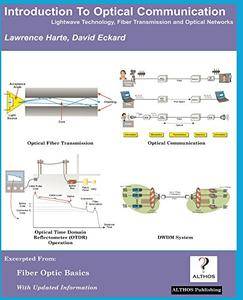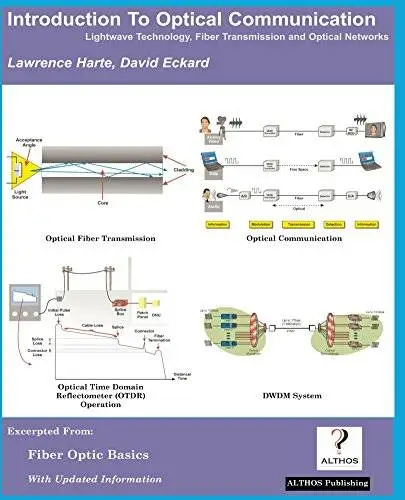Introduction to Optical Communication, Lightwave Technology, Fiber Transmission, and Optical Networks by Lawrence Harte
English | 22 Mar. 2017 | ASIN: B06XST2LF6 | 186 Pages | AZW3 | 5.89 MB
English | 22 Mar. 2017 | ASIN: B06XST2LF6 | 186 Pages | AZW3 | 5.89 MB
This book explains how optical communication systems are used to provide high-speed communication connections. You will learn basic optical principles including how to create and detect light signals, reflection and refraction, basic lightwave propagation and optical signal processing. Provided is an overview of the components and basic operation of optical systems including synchronous optical network (SONET), synchronous digital hierarchy (SDH), fiber distributed data interface (FDDI), passive optical networks (PON) and dense wave division multiplexing (DWDM). The common types of network equipment such as ONU, ADM, and optical switches are described. Discover how optical transmitters and modulators operate including light emitting diodes (LEDs) and LASERS. The differences between these light sources are explained along with how some types of light sources are better suited to send information over short and long distances. Fiber optic transmission is described including how single mode and multimode optical fibers operate along with their transmission characteristics. You will learn how modal dispersion, material dispersion and cable bending affects the performance and ability of fiber cable to transfer light signals. The methods and devices used to couple light signals into and out of fiber cables are discussed. You will discover how photodetection and optical receivers convert optical signals into electrical signals along with the different types of photodetectors and their ability (sensitivity) to light signals. Explained are the basics of how optical demodulation and demultiplexing are used to receive and separate multiple wavelengths of optical signals. An introduction to testing in optical systems is included. The basic methods of optical fiber testing including continuity testing and measuring optical loss is included. Discover how to use an optical time domain reflectometer (OTDR) to identify the specific locations of breaks or distortions in fiber cable. Learn the basic steps for fiber optic link and system acceptance testing. Troubleshooting processes and tips are included to help you diagnose and repair equipment and link failures along with how to maintain maintenance records. Some of the most important topics featured in this book are: • Ways to send data via optical systems
• Optical Communication fundamentals
• Single mode and multimode fiber transmission
• LED and Laser Light Transmitters
• Photodetectors and Optical Receivers
• Lightwave switching
• Optical network functional parts
• SONET/SDH, FDDI, PON and DWDM systems
• Testing optical networks



